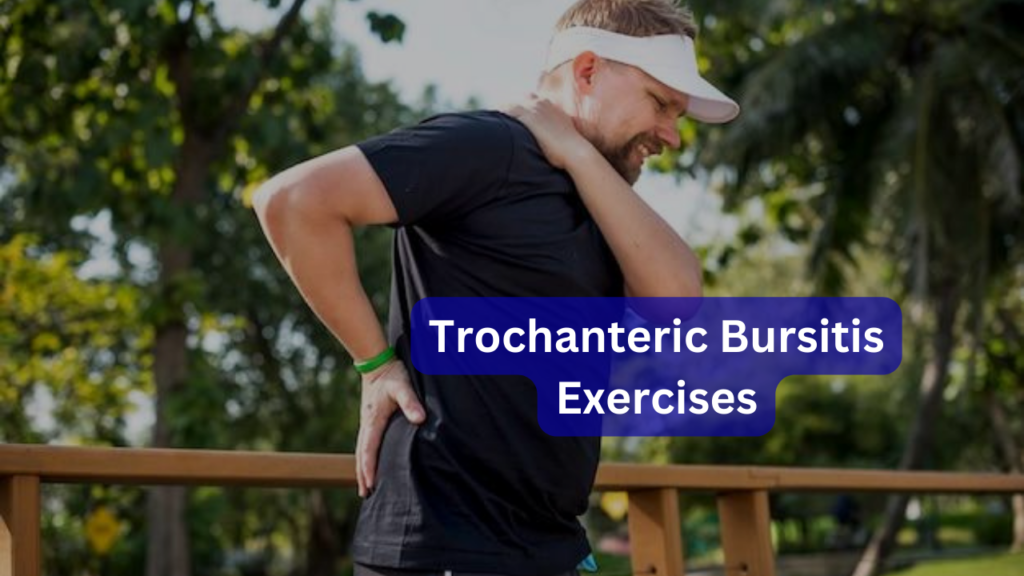Hip pain can be a real drag, hindering your daily activities and putting a damper on your mood. If you’re experiencing discomfort on the outer side of your hip, trochanteric bursitis might be the culprit.
This common condition inflames the bursa, a fluid-filled sac that cushions the greater trochanter bone (the bony bump on your upper thigh). While it can be painful, the good news is that trochanteric bursitis is often treatable, and specific trochanteric bursitis exercises can play a key role in your recovery.
Understanding Trochanteric Bursitis
The bursa helps reduce friction between your tendons and the greater trochanter bone. However, repetitive stress, tight muscles, or even sleeping on your side can irritate the bursa, leading to inflammation and pain. Symptoms of trochanteric bursitis include:
- Pain: Aching or sharp pain around the outer hip, often worse with lying on the affected side, climbing stairs, or running.
- Tenderness: Touching the area around the greater trochanter bone can be tender.
- Stiffness: Reduced range of motion in the hip joint, making it difficult to bend or extend the leg.
- Weakness: The affected leg may feel weak, making activities like walking or standing challenging.
Seeking Medical Attention

While trochanteric bursitis often improves with self-care measures, consulting a healthcare professional is crucial for proper diagnosis and treatment. They can assess the severity of your condition, rule out other potential causes of your hip pain, and recommend the most effective treatment plan. This may include:
- Rest: Avoiding activities that aggravate the pain is essential for allowing the bursa to heal.
- Ice: Applying ice packs to the affected area for 15-20 minutes at a time, several times a day, can reduce inflammation and pain.
- Pain relievers: Over-the-counter pain relievers like ibuprofen or acetaminophen can help manage pain and discomfort.
- Physical therapy: A physical therapist can design a personalized exercise program to strengthen the muscles around the hip joint, improve flexibility, and prevent future flare-ups.
- Cortisone injections: In severe cases, your doctor may recommend cortisone injections to reduce inflammation and provide quick pain relief.
4 Effective Trochanteric Bursitis Exercises
Once you’ve received proper diagnosis and guidance from your healthcare professional, incorporating specific exercises into your routine can significantly accelerate your recovery and prevent future recurrences. Here are some key exercises to target:
Clamshells
This exercise strengthens the gluteal muscles, which stabilize the hip joint and reduce pressure on the bursa.
- Lie on your side with your knees bent and stacked.
- Keep your feet together and knees aligned with your hips.
- Slowly raise your top knee upwards, keeping your feet together and engaging your glutes.
- Hold for a second, then slowly lower your knee back down.
- Repeat 10-15 times on each side.
Side-lying leg lifts
This exercise strengthens the hip abductor muscles, which help stabilize the hip joint and prevent inward movements that can irritate the bursa.
- Lie on your side with your bottom leg bent and your top leg straight.
- Keep your core engaged and lift your straight leg up as high as you comfortably can without twisting your hips.
- Hold for a second, then slowly lower your leg back down.
- Repeat 10-15 times on each side.
Hip bridges
This exercise strengthens the core and gluteal muscles, providing overall stability and support to the hip joint.
- Lie on your back with your knees bent and feet flat on the floor.
- Lift your hips off the ground, squeezing your glutes and keeping your back straight.
- Hold for a few seconds, then slowly lower your hips back down.
- Repeat 10-15 times.
Wall slides
This exercise improves hip mobility and flexibility, reducing tightness that can contribute to bursitis.
- Stand facing a wall with your feet shoulder-width apart.
- Lean back slightly and place your hands flat on the wall at shoulder height.
- Slowly slide your hands down the wall, keeping your back straight and core engaged.
- Slide down as far as comfortable, then slowly slide back up.
- Repeat 10-15 times.
Additional Exercises and Tips for Trochanteric Bursitis Relief

Beyond the five core exercises, several other options can be beneficial in your trochanteric bursitis recovery journey:
- Pilates: Pilates exercises focus on core strength and stability, which can significantly improve hip function and reduce pain. Consider joining a Pilates class or following online tutorials for targeted exercises.
- Yoga: Gentle yoga poses emphasizing hip mobility and stretching can be helpful. Look for yoga routines specifically designed for hip pain or consult a certified yoga instructor for personalized guidance.
- Foam rolling: Using a foam roller can help release tightness in the muscles surrounding the hip joint, improving flexibility and reducing inflammation. Focus on rolling the outer thigh muscles and glutes.
- Aquatic therapy: Exercising in water provides gentle resistance and buoyancy, reducing stress on the hip joint while allowing for movement. Consider aqua therapy classes or simply performing the exercises mentioned above in a pool.
Remember:
- Listen to your body: Pay close attention to your pain level and avoid any exercise that worsens it. Stop immediately if you experience sharp pain or discomfort.
- Start slow and gradually increase intensity: Begin with a few repetitions of each exercise and gradually increase as your pain improves and strength builds.
- Warm-up and cool down: Before starting your workout, perform light cardio and dynamic stretches to warm up your muscles. After your exercise routine, cool down with static stretches to improve flexibility and prevent injury.
- Maintain proper form: Focus on correct form during exercises to ensure you’re targeting the right muscles and avoiding unnecessary strain. Don’t hesitate to ask a healthcare professional or physical therapist for guidance on proper technique.
- Be patient: Recovery from trochanteric bursitis takes time. Be patient with your progress and celebrate small improvements along the way.
Additional Strategies for Managing Trochanteric Bursitis
- Weight management: Maintaining a healthy weight can reduce stress on the hip joint and improve overall pain management.
- Ergonomics: Pay attention to your posture and body mechanics during daily activities. Avoid repetitive movements that can aggravate the bursa.
- Supportive shoes: Wearing proper shoes with good arch support can help distribute weight evenly and reduce stress on the hip joint.
- Alternative pain relief options: Consider using heat therapy pads, topical pain relievers, or TENS units for additional pain management.
Remember, seeking professional medical advice is crucial for the proper diagnosis and treatment of trochanteric bursitis. While these exercises and tips can be valuable tools in your recovery journey, they should not replace professional medical guidance.
Living with Trochanteric Bursitis

Managing trochanteric bursitis in your daily life is crucial for preventing flare-ups and maintaining long-term comfort. Here are some tips:
- Modify activities: Avoid activities that trigger your pain, such as running on hard surfaces or climbing stairs. Choose low-impact exercises like swimming, cycling, or elliptical training.
- Listen to your body: Don’t push yourself too hard. Take breaks when needed and rest when you feel pain.
- Maintain a healthy lifestyle: Eat a balanced diet, get enough sleep, and manage stress levels to support your overall health and recovery.
- Stay active: Regular physical activity, even gentle movement, can help improve your range of motion and prevent future episodes of bursitis.
- Seek support: Talk to your doctor or a physical therapist about your concerns and challenges. They can provide ongoing guidance and support throughout your recovery journey.
Conclusion
Trochanteric bursitis can be a painful condition, but with proper diagnosis, treatment, and self-care, you can find relief and regain your active lifestyle. Remember, incorporating the exercises and tips mentioned above into your routine, along with seeking professional medical guidance, can significantly improve your recovery and prevent future flare-ups. So, take charge of your health, listen to your body, and conquer that hip pain!
Resources and References
- American Academy of Orthopaedic Surgeons: https://www5.aaos.org/store/product/?productId=18009498&ssopc=1
- Mayo Clinic: https://www.mayoclinic.org/diseases-conditions/bursitis/diagnosis-treatment/drc-20353247
- National Institutes of Health: https://www.ncbi.nlm.nih.gov/books/NBK513340/
- American Physical Therapy Association: https://www.apta.org/
Disclaimer: This article is for informational purposes only and should not be interpreted as medical advice. Always consult with a healthcare professional for diagnosis and treatment of any medical condition.
FAQs about Trochanteric Bursitis Exercises
How often should I do trochanteric bursitis exercises?
Start slowly and gradually increase frequency as your pain improves. Begin with 2-3 sets of 10-15 repetitions for each exercise, 2-3 times a day. As your pain decreases and strength builds, you can increase the sets and repetitions to 3-4 sets of 15-20 repetitions, 2-3 times a day. However, always listen to your body and stop if you experience any sharp pain or discomfort.
Which exercises are the most effective for trochanteric bursitis?
Several exercises can be beneficial, but some of the most effective include:
- Clamshells: Strengthen the gluteal muscles for hip stability.
- Side-lying leg lifts: Strengthen the hip abductor muscles for inward hip movement control.
- Hip bridges: Strengthen the core and gluteals for overall hip joint support.
- Wall slides: Improve hip mobility and flexibility.
- Gentle stretches: Focus on stretching the hip flexors, hamstrings, and glutes to improve the range of motion.
Can I do other exercises besides the ones mentioned?
Yes, you can incorporate other low-impact exercises into your routine, such as swimming, cycling, or elliptical training, as long as they don’t aggravate your pain. Pilates and gentle yoga can also be helpful. However, consult with your doctor or a physical therapist before starting any new exercise program.
What if I experience pain during exercises?
Stop immediately if you experience any sharp pain or discomfort during exercises. This could indicate improper form or a different underlying issue. Consult your doctor or physical therapist for guidance and adjust your exercises accordingly.
How long will it take for the exercises to work?
Recovery time varies depending on the severity of your bursitis and your response to treatment. Be patient and consistent with your exercises. You may start feeling some improvement within a few weeks, but complete recovery can take several months.
Can I do anything else besides exercises to relieve trochanteric bursitis pain?
Yes, several additional strategies can help manage your pain:
- Rest: Avoid activities that aggravate your pain.
- Ice: Apply ice packs to the affected area for 15-20 minutes at a time, several times a day.
- Pain relievers: Over-the-counter pain relievers like ibuprofen or acetaminophen can help manage pain.
- Heat therapy: Applying a heating pad after activity can help relax muscles and reduce pain.
- Maintain a healthy weight: Excess weight can put additional stress on the hip joint.
- Wear supportive shoes: Proper shoes with good arch support can help distribute weight and reduce stress on the hip.


